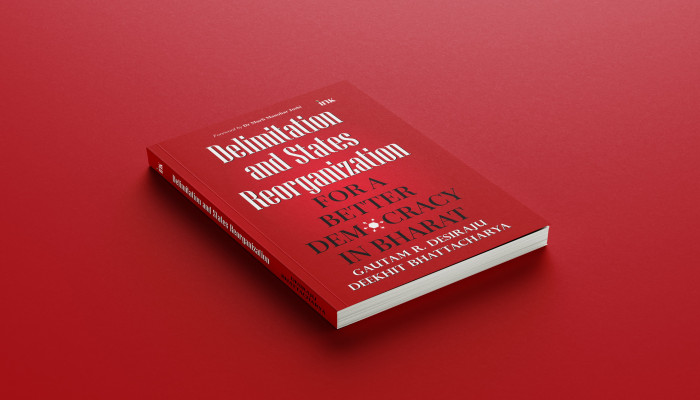Delimitation and States Reorganization: For a Better Democracy in Bharat
- In Book Reviews
- 09:44 AM, Jun 09, 2025
- Ramaharitha Pusarla
Teeming with 1.4 billion people, India has set a lofty goal of Viksit Bharat 2047 on the strength of three Ds- Demography, Demand and Democracy. Marked by a peaceful transition of power and a five-year periodic cycle of free and fair elections, India burnishes its democratic credentials.
India has been the mother of Democracy, which has been the hallmark of mature civilisations. Self-governance and devolution of power, the vital elements of a democratic setup, have been integral to Bharatiya society even before the Mauryas and Guptas. Notably, despite sheer geographic separation, similar democratic impulses existed in Greece. While the capricious Amerisphere think-tanks designate India as an ‘electoral autocracy’, based on its Christianised version of democracy, passages in the Rig Veda Mandalas and Atharva Veda vividly describe the election of ‘rajan’ by the Samiti. Democratic system existed in various forms in India from the Vedic times. Clearly, no country, including the West, can have a monopoly over the term ‘Democracy’ and can’t be allowed to set normative benchmarks in judgment of other countries under the garb of ‘rules-based order’.
Unfortunately, waves of foreign invasions have irretrievably disturbed the embedded democratic principles of Bharatiya society. Over two centuries long British colonisation had left a deep imprint on the body politic of India. Having mastered the art of weaponisation of identity markers like religion, caste and language, the British created fissures in the Indian society. The brutal partition of India is rooted in these divisive identity politics, which are a threat to the unity of the country. However, for quick political gains, regional political parties deliberately latch onto identity politics to mobilise the electorate. Unity in diversity is the bedrock of Indian civilisation. The heightened assertion of identities coupled with a renewed call for a freeze on delimitation can be inimical to the democratic framework of any country.
Countering this frenzy, authors Gautam R Desiraju and Deekhit Bhattacharya have brought out a book, “Delimitation and States Reorganization For A Better Democracy in Bharat”, a sequel to Bharat: India 2.0 (authored by Prof. Desiraju), offering a bold, new framework for reshaping the Indian States. Discarding the time-worn dogmatic methodology, the book gets to the root of the growing trend of identity politics. For their administrative convenience to strengthen their hold on India, the British encouraged provincial reorganisation along the linguistic lines. Soon, the political identity on linguistic lines was firmly instilled in people by around 1920. Ever since, regardless of history, culture and tradition, language emerged as the primary identity of people.
The rise of linguistic consciousness soon bred the supremacist political idea, triggering the genesis of exclusivist political parties that seeded linguistic and cultural chauvinism. During the freedom movement, these hardened linguistic identities dented the national unity by fostering sub-nationalism. Identifying Tamil language as a vector, missionaries instilled the Dravidian ideology in the Madras Province by propping up the caste divisions and designating Nadars as non-Aryan. By turning language into a vector of social engineering, the British successfully drilled in the idea of separateness and sowed seeds of division between Bharat and the Tamil people.
Upholding the objectives of the Justice Party that advocated Dravidian ideology, its offshoots are now stoking embers of separateness in Tamil Nadu. The recent doubling down on imagined Hindi-language imposition and demand for a further freeze on delimitation, provoking the North-South divide indeed warrants a serious relook at the reorganizational framework of States.
Acknowledging “Tamil language as the totem of Dravidianism”, the authors hark back to the failures of the political leadership of independent India that unsuspectedly adopted linguistic reorganisation of States. Strangely, the 1956 States Reorganisation Commission of independent India echoed the British approach of “convenience and apathy” in carving new states based on language, disregarding the economic concerns and cultural identities of the people. Applying the theme of “One Language One State”, new states were formed conforming to a new uniform identity of language, resulting in the suppression of other dialects.
This larger fragmentation created artificial homogenisation, loss of cultural diversity and accentuated dissimilarities between states. With no rationale for the division and application of metrics, India ended up having disparate states with some wielding outsized political heft. This has destabilised the crosstalk between the Unitary (Centre) and peripheral units (States). Centrifugal disruptive tendencies of the states can impact the overall unity of the country.
To stem this rising sub-nationalism and the arm-twisting of States with disproportional electoral heft, the authors recommend the creation of 75 small states based on a common ethnicity, historical connections, language, and culture that enhances self-worth, linguistic pride and self-development. Asserting that the reorganisation of states and delimitation are two sides of the same coin, the book strongly recommends delimitation of States based on the census scheduled for March 2027.
The principle of equal representation is paramount in democracy. The potential of national diversity can be best represented with “Each Vote Same Value and Each State Same Heft”. The authors believe that reorganisation into smaller units of an average 2 crore population can herald mental decolonisation, inspire citizens to embrace their civilizational identities unapologetically. In fact, small states with optimal population size and diversity, besides augmenting the country’s potential, can promote true federalism. If states are roughly the same size, none would have disproportionate heft.
The authors strongly recommend that the Centre must bite the Delimitation bullet frozen for 50 years, against the 10-year renewal after every census. The last delimitation exercise was carried out based on the 1971 census. Boundaries were readjusted in 2001, but the number of Lok Sabha and Assembly constituencies remained the same. Small states can resolve the inconsistencies of demography, economy and federal impulses to a large extent. Currently, the average voters represented by an Lok Sabha MP is 17.9 lakh, more than the size of Sweden. ‘Delimitation helps in realignment and reemergence of new power dynamics’.
Advocating for an extremely onerous task of delimitation, which involves demographic, political and legal complexities, the authors want the exercise to be done ‘ab initio’ not incrementally. As per Article 3 of the Indian Constitution, Parliament can form new states and redraw the existing boundaries. Delimitation is the first step in reshaping and reimagining India.
‘Bharat is an ancient civilisation, India is a new country’ trapped in the Westphalian artifice of the nation state. India has given in to the British imposition of institutionalised linguistic identity. British model can be exemplified by Winston Churchill’s statement, “India is a geographical term. It is no more a united nation than the equator”. As the authors rightly contend, “intellectual colonisation outlasts political colonisation”, and the Indian elite looking at India through the British lens has embellished and institutionalised this lie.
Indeed, the “Western notion of federalism rooted in the Roman idea, of varied peoples pooling together select political power as foederatis makes little sense in the Indian context- our model is of singular all-pervading Brahman manifesting itself in many forms by declaring ‘May I be many, may I grow forth’ instead of preexisting bits and pieces of agglomerating together”.
Offering a compelling logic, the authors present Dr. Ambedkar’s note on the 1956 SRC entitled “Thoughts on Linguistic States”. He wrote, “The formation of Linguistic States, although essential, cannot be decided by any sort of hooliganism. Nor must it be solved in a manner that will serve party interest. It must be solved by cold-blooded reasoning”. Suggesting an alternative foundation, the authors have come up with the idea of “One Language One State”.
Forwarded by Dr. Murli Manohar Joshi, the 245-page book comprising five chapters offers prescriptive solutions and an actionable plan for India aspiring to rediscover, reclaim its civilizational identity. Presenting a clear distinction in the end goals of a nation state and a civilizational state, rooted in a Dharmic foundation, the authors provide a blueprint that necessitates the reorganisation of States and a new constitution that resonates with the values and aspirations of people.
Historically, Bharat had small states, and the new model of 75 states aligns with the time-tested idea that uncompromisingly nurtures diversity, which is the essence of our civilisation. With a nationalist dispensation at the helm, India is going through a silent churn. The dispassionate visionary blueprint etched out by the authors to make India a better democracy deserves huge applause. The roadmap is reflective of their desire in India’s emergence as a civilisation state. The book is timely and a must-read.
Printed Pages: 245
Publishers: Bluoneink, OCCAM
P.S. Thank you, Indica Books, for the hard copy!!
Image source: Bluoneink
Disclaimer: The opinions expressed within this article are the personal opinions of the author. MyIndMakers is not responsible for the accuracy, completeness, suitability, or validity of any information on this article. All information is provided on an as-is basis. The information, facts or opinions appearing in the article do not reflect the views of MyindMakers and it does not assume any responsibility or liability for the same.







Comments